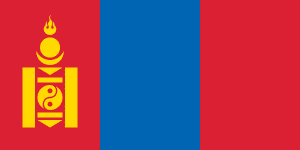
| Colors | HEX Code | RGB | CMYK |
|---|---|---|---|
| Red | #DA2032 | 218, 32, 50 | 0, 85, 77, 15 |
| Blue | #0066B3 | 0, 102, 179 | 100, 43, 0, 30 |
| Yellow | #FFD900 | 255, 217, 0 | 0, 15, 100, 0 |
The flag of Mongolia has three unequal vertical stripes colored red and blue. The stripes at the hoist and fly sides are red, while the middle stripe is blue. On the hoist side, there are yellow symbols on the red stripe that represent the Soyombo, a Mongolian emblem.
Meaning of the Mongolian Flag
Mongolia’s flag blue center symbolizes the eternal blue sky; the two red sides symbolize progress and prosperity. The golden Soyombo stands for the Mongolian cultural heritage and beliefs. A flame at the top represents the family. The three prongs signify prosperity for the Mongolian people in the past, present, and future. The sun and crescent stand for eternity and the origin of the nation. The circle in the center of the flag is said to be the Buddhist yin and yang symbol, but it also represents two fish that never close their eyes as a symbol of the watchfulness and alertness of Mongolia. The triangles are for the people’s determination to defend the country’s freedom and independence. The rectangles stand for protection.
History of the Mongolian Flag
Genghis Khan established the Great “Mongol Empire” in 1206. Then in the 17th century, the Qing dynasty controlled Mongolia. Mongolia gained independence in 1911. Its flag was a red field bordered with yellow, and a yellow group of symbols in the middle. A few years later, Chinese troops occupied Mongolia. Mongolia remained under Chinese rule until July 11, 1921, when they gained independence. The flag was changed to a red flag with a yellow sun and a crescent in the canton. The flag was changed several times as Mongolia witnessed political changes. The last version of the flag was officially adopted in 1992.